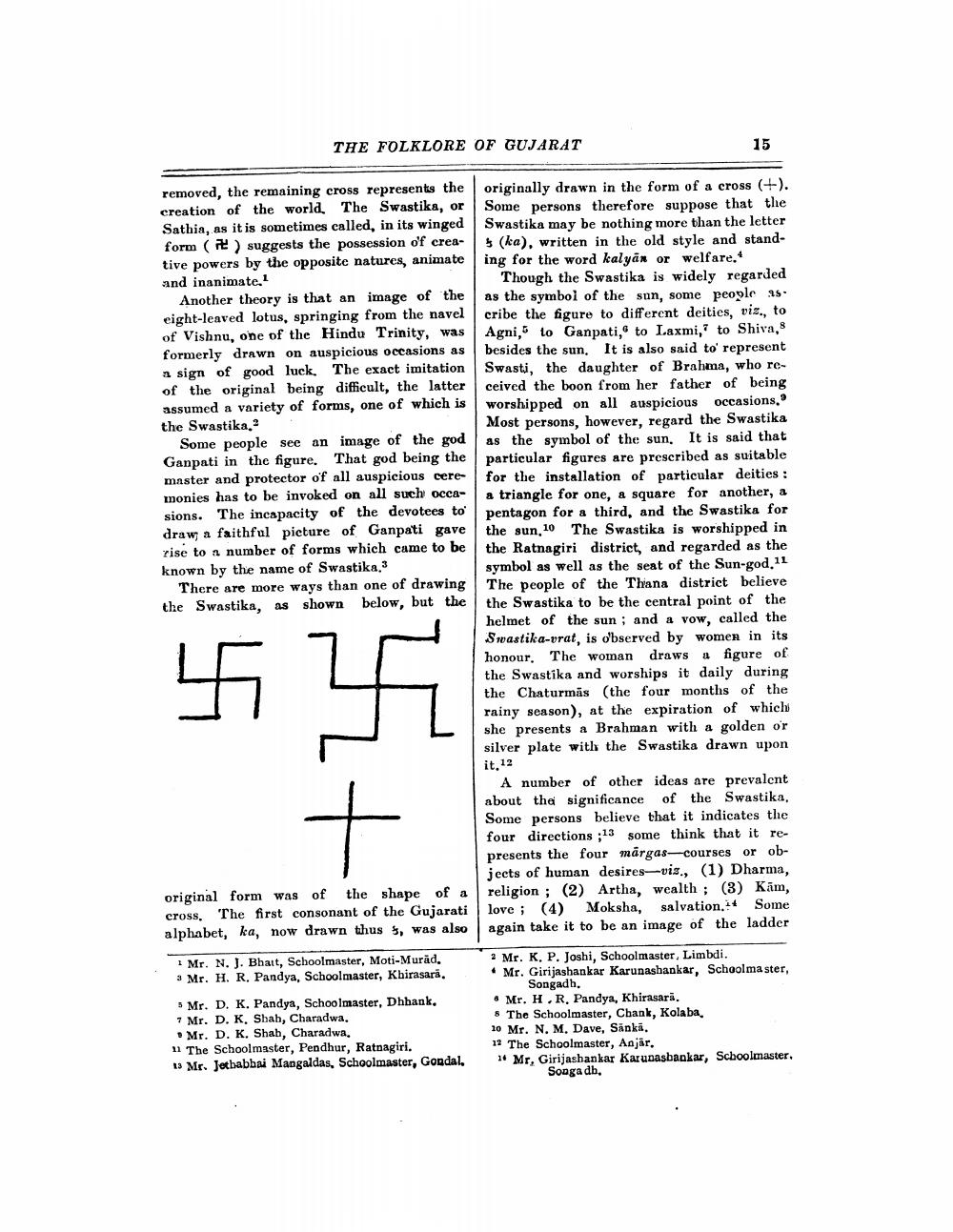________________
THE FOLKLORE OF GUJARAT
15
removed, the remaining cross represents the originally drawn in the form of a cross (+). creation of the world. The Swastika, or Some persons therefore suppose that the Sathia, as it is sometimes called, in its winged Swastika may be nothing more than the letter form( ) suggests the possession of crea- (ka), written in the old style and standtive powers by the opposite natures, animate ing for the word kalyan or welfare. and inanimate. 1
Though the Swastika is widely regarded Another theory is that an image of the as the symbol of the sun, some people as. eight-leaved lotus, springing from the navelcribe the figure to different deities, viz., to of Vishnu, one of the Hindu Trinity, was Agni," to Ganpati, to Laxmi,' to Shiva, formerly drawn on auspicious occasions as besides the sun. It is also said to represent a sign of good luck. The exact imitation Swasti, the daughter of Brahma, who reof the original being difficult, the latter ceived the boon from her father of being assumed a variety of forms, one of which is worshipped on all auspicious occasions, the Swastika. 2
Most persons, however, regard the Swastika Some people see an image of the god as the symbol of the sun. It is said that Ganpati in the figure. That god being the particular figures are prescribed as suitable master and protector of all auspicious cere for the installation of particular deities : monies has to be invoked on all such occa- a triangle for one, a square for another, a sions. The incapacity of the devotees to
pentagon for a third, and the Swastika for draw a faithful picture of Ganpati gave the sun 10 The Swastika is worshipped in rise to a number of forms which came to be the Ratnagiri district, and regarded as the known by the name of Swastika,3
symbol as well as the seat of the Sun-god. 11 There are more ways than one of drawing The people of the Thana district believe the Swastika, as shown below, but the the Swastika to be the central point of the
helmet of the sun ; and a vow, called the Swastika-vrat, is observed by women in its honour. The woman draws a figure of the Swastika and worships it daily during the Chaturmās (the four months of the rainy season), at the expiration of which she presents a Brahman with a golden o'r silver plate with the Swastika drawn upon
it, 12
A number of other ideas are prevalent about the significance of the Swastika, Some persons believe that it indicates the four directions ;13 some think that it represents the four mārgas-courses or objects of human desires-vis., (1) Dharma, religion ; (2) Artha, wealth ; (3) Kām, love ; (4) Moksha, salvation. Some again take it to be an image of the ladder
original form was of the shape of a cross. The first consonant of the Gujarati alphabet, ka, now drawn thus 3, was also
1 Mr. N. J. Bhatt, Schoolmaster, Moti-Murad. 3 Mr. H. R, Pandya, Schoolmaster, Kbirasara.
Mr. D. K. Pandya, Schoolmaster, Dhbank. 7 Mr. D. K. Shah, Charadwa,
Mr. D. K. Shah, Charadwa. 11 The Schoolmaster, Pendhur, Ratnagiri. 13 Mr. Jethabbai Mangaldas, Schoolmaster, Gondal,
2 Mr. K. P. Joshi, Schoolmaster, Limbdi. • Mr. Girijashankar Karunashankar, Schoolmaster,
Songadh. • Mr. H.R. Pandya, Khirasarā.
The Schoolmaster, Chank, Kolaba. 10 Mr. N. M. Dave, Sankā. 12 The Schoolmaster, Anjär, Mr, Girijashankar Karunasbankar, Schoolmaster,
Songa db,




